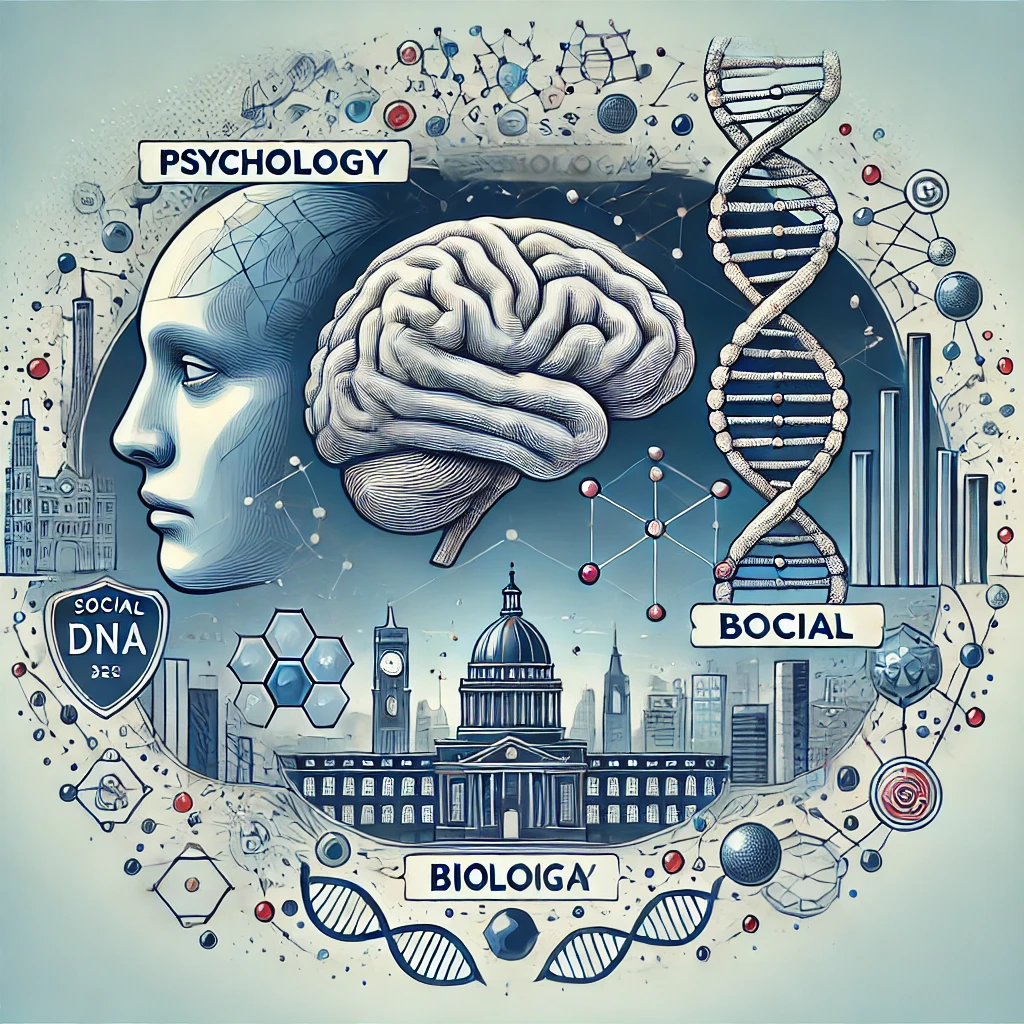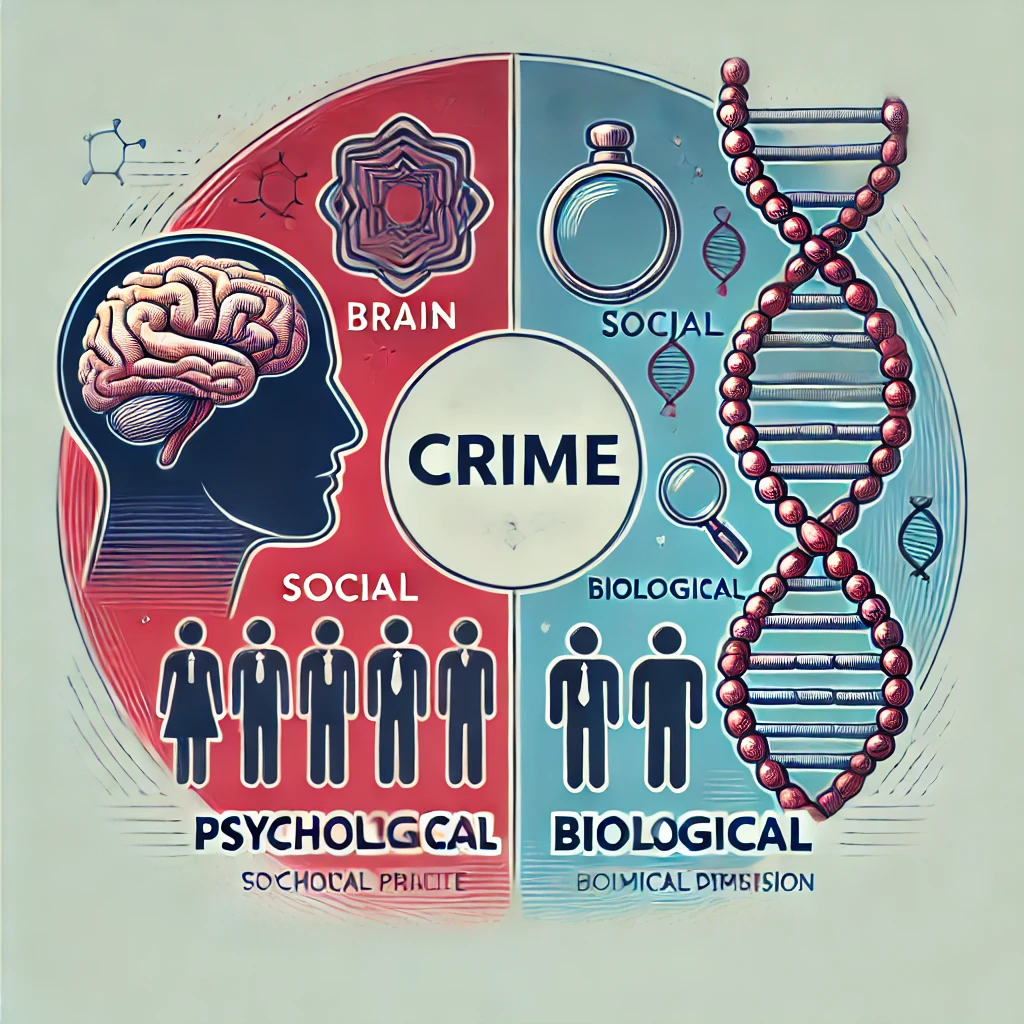Crime is a multifaceted phenomenon influenced by an interplay of psychological, social, and biological factors. Understanding these dimensions is crucial for comprehending criminal behavior and developing effective prevention strategies. This article explores the psychological, social, and biological underpinnings of crime, highlighting their significance in criminological studies and practical applications.
1. Psychological Dimensions of Crime
The psychological perspective emphasizes the mental processes, personality traits, and cognitive patterns that drive criminal behavior.
The Role of Mental Health
Mental health disorders, such as antisocial personality disorder or psychopathy, have been closely linked to certain types of criminal behavior. Studies indicate that untreated mental illnesses can increase the risk of impulsive actions, violence, or theft.
Cognitive Theories
Cognitive distortions, such as justifying harmful actions or perceiving others as threats, often underlie criminal activities. Theories like Bandura’s social learning theory suggest that individuals may adopt criminal behaviors by observing and imitating others, especially in environments where such behaviors are normalized.
Personality Traits and Crime
Traits such as impulsivity, aggression, and a lack of empathy are associated with higher tendencies toward criminal behavior. The Big Five personality model highlights that low conscientiousness and low agreeableness can predict delinquency.
Therapeutic Interventions
Psychological approaches like cognitive-behavioral therapy (CBT) aim to address distorted thinking patterns and reduce recidivism. Rehabilitation programs focusing on emotional regulation and impulse control have shown promising results in decreasing criminal behavior.
2. Social Dimensions of Crime
Crime does not occur in isolation; it is deeply embedded in social contexts. Societal structures, relationships, and cultural norms play pivotal roles in shaping criminal behavior.
The Impact of Socioeconomic Status
Poverty, unemployment, and lack of access to education are significant contributors to crime. Economic disparities create environments where individuals may resort to illegal activities for survival or social mobility.
Family and Peer Influences
Family dynamics, including neglect, abuse, or inconsistent discipline, can predispose individuals to criminal behavior. Similarly, peer pressure and associations with delinquent groups often encourage participation in illegal activities, particularly among adolescents.
Cultural and Subcultural Norms
Certain subcultures may glorify or normalize criminal behavior, such as gang affiliations or communities with high levels of violence. The concept of “anomie,” introduced by Durkheim, highlights how societal breakdowns in norms and values can lead to deviant behaviors.
Social Policies and Prevention
Community programs that address social inequalities, provide educational opportunities, and foster positive relationships can significantly reduce crime rates. Initiatives like neighborhood watch programs and after-school activities have proven effective in crime prevention.

3. Biological Dimensions of Crime
Biological factors, including genetics, neurophysiology, and hormonal influences, offer insights into the predispositions for criminal behavior.
Genetic Influences
Research in behavioral genetics suggests that certain genetic markers may be linked to aggressive or impulsive behaviors. Twin and adoption studies indicate that genetics account for a portion of the variance in antisocial behaviors, though environmental factors also play a crucial role.
Neurological and Brain Function
Abnormalities in brain structures, such as the prefrontal cortex, are associated with impaired decision-making and lack of impulse control, common traits in offenders. Advances in neuroimaging have revealed that individuals with a history of violent crime often exhibit reduced activity in areas responsible for empathy and moral reasoning.
Hormonal and Chemical Factors
Imbalances in hormones like testosterone or neurotransmitters such as serotonin can influence aggression and impulsivity. Elevated levels of testosterone, for instance, have been linked to increased risk-taking and violent behavior.
Nature vs. Nurture Debate
While biological predispositions provide a foundation for understanding criminal tendencies, their expression is often mediated by environmental factors. For example, a genetic predisposition for aggression may only manifest in individuals exposed to adverse childhood experiences.
Medical Interventions
Pharmacological treatments targeting neurotransmitter imbalances or hormonal therapies may complement traditional rehabilitation methods, offering new avenues for reducing criminal tendencies.
4. Integrative Perspectives and Applications
While psychological, social, and biological dimensions offer distinct insights, integrating these perspectives provides a more comprehensive understanding of crime.
The Biosocial Model
This model emphasizes the interaction between biological predispositions and environmental factors. For instance, a person with genetic vulnerabilities may be more likely to engage in criminal behavior if exposed to adverse social conditions, such as poverty or peer influence.
Case Studies
- Psychological Focus: Examining the life of a serial offender may reveal a history of trauma and cognitive distortions.
- Social Focus: Analyzing crime in economically disadvantaged neighborhoods highlights systemic issues contributing to higher crime rates.
- Biological Focus: Studies of violent criminals may uncover neurophysiological abnormalities that impair impulse control.
Policy Implications
Understanding these dimensions informs public policies and criminal justice practices. For example:
- Psychological insights can improve rehabilitation programs.
- Social findings can guide community-based crime prevention initiatives.
- Biological research can lead to advancements in medical interventions and risk assessment tools.
Conclusion
Crime is a complex interplay of psychological, social, and biological factors. Each dimension offers unique insights, but a holistic approach is essential for addressing the root causes and consequences of criminal behavior. By combining these perspectives, researchers, policymakers, and practitioners can develop more effective strategies to prevent crime, rehabilitate offenders, and promote safer societies. As the field of criminology evolves, embracing interdisciplinary methods will remain crucial for understanding and mitigating crime’s multifaceted nature.

